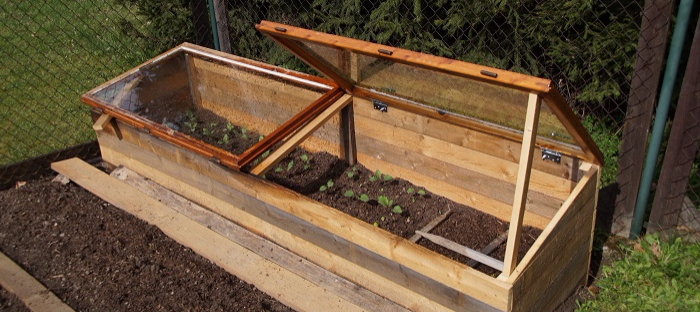You may have just finished planting in the summer, but your cold frame will be needed sooner than you expect.
Summer has finally arrived in most U.S. Gardeners will use their cold frames less as the conditions are perfect for in-ground plantation. But because temperatures have soared and frost warnings have long passed doesn’t mean it’s time to abandon your cold frame. It’s best to clean and inspect your cold frames, greenhouses, and other outdoor structures now so that they are ready to go when the time comes to transition to fall gardening.
We know that you have a lot of work to do in the summer. For example, you are sowing warm-weather crops or dealing with weeds. If you spend a few moments cleaning your cold frame, you’ll have time to do any repairs or upgrades you need before cool weather arrives in your area. Don’t worry if you have never thought about cleaning your cold frame. The process is simple, quick, and offers many benefits.
Remove the plants that didn’t make it.
Most gardeners have a few pots of dirt left over from seedlings that failed to flourish. Please get rid of any weak, unhealthy, or dead plants and their containers to free up some space. This will allow you to clean your cold frame thoroughly later. You can also use this time to determine what materials you need to overwinter and garden in cool weather. You’ll want any old seedling starter or potting mix to keep when you discard your failed garden experiments. This material can be given a new lease of life by adding soil amendments like Compost or earthworm castings. This soil will soon be rich enough to grow your subsequent seedlings.
Look for Broken Parts
The most important part of a cold frame is the plastic or glass cover, which traps heat and sunlight. It’s time to replace any plastic or glass that is cracked. You’ll also want to ensure that all aspects of your cold frame are fully functional. Repairs on a rainy and cold day are not a good idea. Check your hard frame hinges, door props, and chains thoroughly.
You’ll need to check that the frame of your cold frame is sturdy and reliable, regardless of whether it was made from wood, plastic, metal, or straw. Weak or broken walls can be a problem during the winter months and threaten your cool-weather crops. If your cold frame has been anchored, you’ll want to check that the anchors are still securely rooted in the ground. This is common in windy areas. You can also remove the anchors and clean and store smaller cold frames in the summer months to protect them against harsh weather conditions. You can decide now, but noting the necessary repairs will allow you several months to collect new parts, supplies, and funds. This is especially useful for those who are on a tight budget or with a busy schedule.
Give it All a Good Scrub.
You’ll have to treat your cold frame with the same care you give to rakes and shovels. Glass and plastic panes accumulate dirt and grime over the year. A thorough scrub should clear the way for your new seedlings. It’s essential to clean the frame, mainly if mildew or mold is growing. Mix one part soap, ten parts bleach, and 20 parts water to make your cleaning solution. It is essential to clean your cold frames regularly to remove any bacteria which may have led your plants or seedlings to fail. This will also increase the longevity of your hard frame. It won’t help materials that have already been damaged or are decaying. Replace these parts as soon as possible before the fall.
Rebuild Bottom Insulation
Although how each gardener constructs and uses their cold frames will differ, almost all have an insulated bottom. After thoroughly cleaning, you may notice that your hard frame’s bottom insulation looks lackluster. Some people mound dirt at the bottom of cold frames as an additional insulation layer. Wait until the temperatures drop before you line your shelves with hay or other materials. Don’t let them break down or overheat in the middle of summer!
Rethink Your cold frame’s placement.
You can increase your chances of success by evaluating the use of cold frames last autumn before you plant any new plants. Some demanding frame users like to use their structures in the morning, while others tilt them so that they can catch the afternoon sun. Consider changing the location of your cold frame depending on where you live and what you plan to grow this year. You’ll find it much easier to move the hard frame now that it is empty. You may want to rethink how you use your cold frame. Some gardeners like to plant their crops directly in the soil within the hard edge, while others prefer to keep their greenery potted. Try something new this year, depending on your preferences.
Start planning (Yes, already!)
You can plan cool-weather crops on warm evenings when you are not in the garden. It may seem early to start planning for fall, but it is the best way to make the most of your cold frame. If you plan to increase the number of cool-weather varieties in your garden and want to be prepared for autumn, then it is best to do this. You can save money for an extra cold frame or find bargains on hardware, yard sales, and auctions.
You can modify your cold frame to suit your needs if you decide it’s not for you. You can remove the top of the hard edge to make a raised bed that is easy to fill, or you can sell it to another gardener to earn extra money!
Cold frames can help help your garden flourish during cool weather. You can get a head start on the fall with extra care during the “off-season” for your cold frames.



